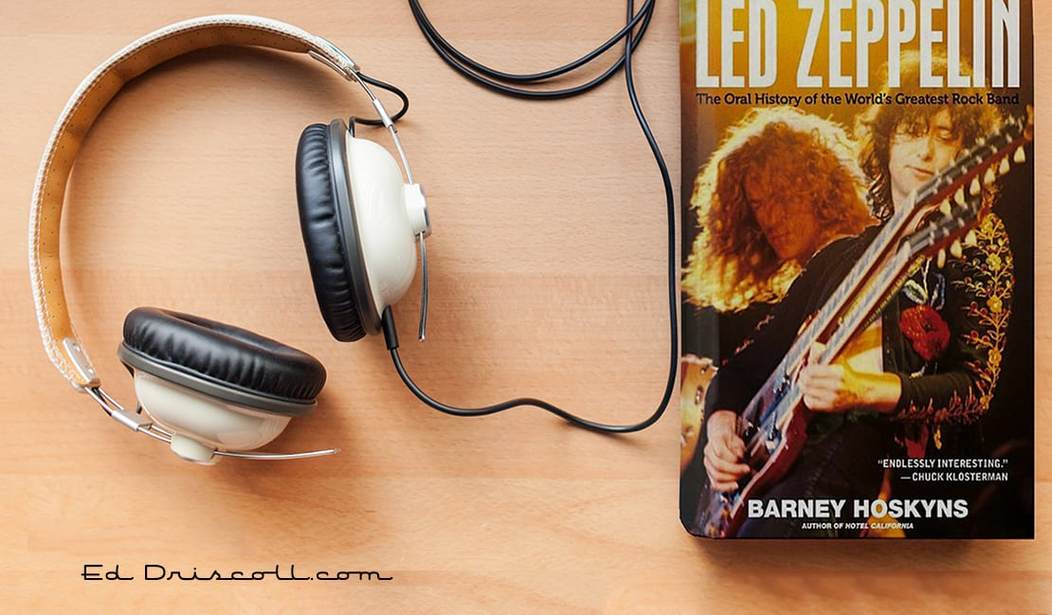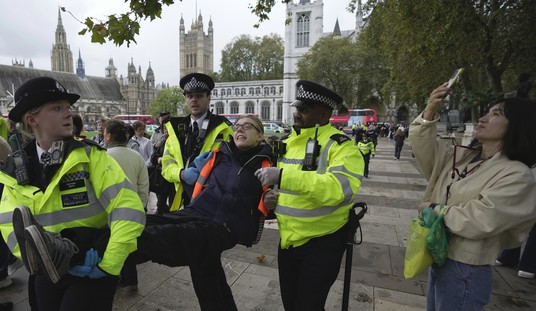In 1964, the Beatles conquered America through the mass medium of television, via their breakthrough performance on Ed Sullivan’s CBS variety show (backed up by a whole lot of marketing by Capitol Records).
By the late 1960s, The Who eventually conquered America thanks to Pete Townshend’s endless (in every definition of the term) interviews with journalists, including Jann Wenner, leader of the burgeoning world of rock journalists.
In 1969, Led Zeppelin conquered America through word of mouth, thanks to their blazing live sets, often as the opening act, blowing the headliner off the stage, and through the new medium of freeform FM radio, whose stations accepted longer songs, and sometimes even whole album sides, to contrast themselves with the 3 minute 15 second AM radio world of pop singles.
Dubbed a hype by the press because of their hard rock sound and enormous signing bonus from Atlantic Records, their debut album trashed mercilessly by Wenner’s Rolling Stone magazine, Led Zeppelin (read: founding member Jimmy Page and manager Peter Grant) treated the press as an enemy to be controlled, manipulated, and often, simply ignored. Interviews would be done strictly on the band’s terms.
Too many details of their lurid excesses could get a reporter kicked off the band’s tour. If, as Glenn Reynolds likes to say, most of today’s political journalists are “Democratic Party operatives with bylines,” Page and Grant knew that most of their music press covering them were wannabe rock stars who wanted to be in on the action themselves – flying on their private tour plane, and sharing in their endless supply of booze and drugs. In the 1990s, Harvey Weinstein knew that Hollywood reporters don’t want to be kicked off the press junkets with their access to stars and easy quotes, and thus could be controlled and manipulated. Page and Grant discovered that nearly 50 years ago.
Which is why the first real biography of Led Zeppelin, Stephen Davis’ The Hammer of the Gods, didn’t appear until 1985, four years after the band had officially broken up, when John Bonham, their drummer, died after his last vodka-fueled drinking binge. Davis’ chief source of insider information was the band’s road manager, Richard Cole, the only member of Zeppelin’s inner circle who didn’t emerge from the 1970s a wealthy man.
The Hammer of the Gods is a book whose every page is a cross between the then-recent rock “mocumentary” This Is Spinal Tap, and the notorious, decadent 1970 film Performance, starring Mick Jagger and Anita Pallenberg, a fictional look at a dissipated rock star, and based in large part on both Jagger and Rolling Stones founder (and former lover of Pallenberg), Brian Jones. While, in retrospect, Davis apparently got most of the basic facts of the band’s history correct, the surviving members of Zeppelin affected a detached “couldn’t be bothered” response when asked by interviewers of the book’s lurid details of mudsharks, underage groupies, and alcohol, cocaine, and later, heroin abuse. But then a funny thing happened: plenty of bands read The Hammer of the Gods not as a warning of the dangers of the excesses of superstardom, but as a how-to guide on living the rock and roll lifestyle in all its extremes. Or as rock author Barney Hoskyns quotes Robert Plant, “I want to believe Hammer of the Gods…because it’s done us huge favors, in terms of aura.”
The Liner Notes of the Gods
Hoskyns’ 2012 book Led Zeppelin: The Oral History of the World’s Greatest Rock Band reads very much like The Hammer of the Gods’ liner notes. Books called “oral histories,” whose authors, acting more like researchers and editors, culled together the best bits of existing interviews with rock stars and arranged them in (more or less) chronological order have been a staple of the book world since the 1970s, if not earlier. But here, Hoskyns takes numerous existing interviews with Zeppelin’s four band members, and includes new interviews with those close to the future band members in the 1960s and those in their orbit during the following decade, for a surprisingly compelling look at how a rock band is first put together in remarkably humble circumstances (initially to fulfill some existing tour dates by Page’s prior group, the Yardbirds), sets a course for stardom, and achieves success and wealth on a scale of excess beyond anything previously seen, including the Beatles. And yet, at the peak of their superstardom, retains a unique level of anonymity and mystery. “The biggest unknown group in the world,” Hoskyns quotes Atlantic impresario Ahmet Ertegun, whose cash flow was built on Zeppelin’s record sales in the 1970s.
The band becomes much less unknown after reading Hoskyns’ Oral History. The quotes assembled in chronological order by Hoskyns sharply illustrate the descent of a band hungry for success into decadence and ultimately disaster by being overwhelmed both by substance abuse, and by the need to maintain the empire. Hoskyns’ Oral History of Led Zep also clears up one of the mysteries of Zeppelin’s incredible financial success: How did manager Peter Grant, who posed as an East End gangster, first get such a huge signing bonus from Atlantic Records in 1968, and then pull off the 90/10 deal that gave Zeppelin a massive percentage of their box office gates? Zeppelin’s secret weapon was their comparatively unknown New York-based attorney, Steve Weiss. Hoskyns quotes Atlantic Founder Ahmet Ertegun saying:
Signing Zeppelin was the result of our signing the Young Rascals. Steve Weiss represented the Rascals in the contract, and he was one of the toughest lawyers I had ever encountered. He made a terrific deal for them. Having done that, he liked us; we became very good friends. When Peter Grant came to America to make a deal for “The New Yardbirds,” Weiss was Grant’s lawyer. So the man we complained about bitterly—because of the tough deal we’d had to make for the Rascals—became our friend. He became the man who brought us one of the greatest groups in the history of music.
Weiss himself describes how he created the 90/10 deal for one of Zeppelin’s inspirations, the great Jimi Hendrix:
Before we started to self-promote [Jimi Hendrix’s] concerts, there was a lot of difficulty in his obtaining dates in America, because at that time—although it seems ludicrous by today’s standards—he was considered to be a very erotic act. Most of the deals available were 60 percent artist, 40 percent promoter. We hired a promoter and paid him a small [10 percent] percentage for promoting the concert. That way, if you did very well, the artist made a lot more of the money. You could only do this with an artist of Jimi’s stature, because if you guessed wrong, the artist wouldn’t make as much or might even lose money.
Sam Aizer, artists relations man who worked with Bad Company out of Zeppelin’s New York Swan Song office, adds:
You want to know what I honestly believe? Steve Weiss was the business brains behind Zeppelin, not Peter. I believe that from my heart. He came up with the 90/10, he came up with all these remarkable ideas. He always gave the credit to “the Leds,” as he called them, but the guy was a genius. Steve could wield somebody else’s power better than anybody—he could squeeze every last nickel. And Peter fed off that. He said, “I’ve got my hired gun, and he’s gonna pull the trigger for me.”
Steve had everything to do with the business mystique of Led Zeppelin. When you walked into that office in the old Newsweek building, there was a hall from Shelley Kaye’s office to Steve’s, with a music room in the middle. In this hall, there were pictures of Led Zeppelin from the first album, and then a little farther down you could see Hendrix, Beck, Vanilla Fudge, the Rascals. And you’d think, “This guy’s been around the block.”
Icarus at the Apogee
As Hoskyns’ book proceeds into Zeppelin’s imperial years in the mid-1970s, the people around the band describe the rot beginning to set in. Fueled by the huge increase in cash-flow that Weiss and Grant manufactured, this period started triumphantly. Zeppelin, Grant, and Weiss set up their record label Swan Song, on which Zeppelin released their blockbuster double-LP set Physical Graffiti. Like the Beatles at their peak, Zeppelin decided they wanted to have their own vanity record label. And like the Beatles, they decided they want to sign additional acts to it, and like the Beatles, they quickly discover that their commitments are extended far beyond their time and interest. And like the Beatles, the drug usage escalates to compensate. (Though far beyond the amounts consumed by the Fab Four in the late 1960s.)
Swan Song’s name and especially its logo, which featured the winged Icarus at the peak of his flight — before the heat of the sun caused his wings to melt, sending him plummeting to his death — would foreshadow bad omens to come. But for now, quickly proving that Swan Song wasn’t entirely a vanity label like Rolling Stones Records, Grant signed Paul Rodgers’ Bad Company to their label. Zeppelin’s 1975 American tour culminated in their playing to a total of 85,000 fans over a five-night set at Earls Court in London, the first time the band could bring the full majesty of their American show to England, with Page wearing his custom-made “Dragon Suit,” lasers, and rear projection video, so that even those in the cheap seats could see close-ups of the band in action. (The videotapes of this footage would form the spine of their 2003 chronological live DVD box set.)
However, in a series of incidents that started almost immediately after the Earl’s Court concerts, Zeppelin became snake-bit. First, Robert Plant and his then-wife were badly injured when their car crashed in Rhodes, Greece. This dovetailed with another development that would have a huge impact on Zeppelin’s last years. In order to turn Plant’s ordeal into something positive for both Plant and the rest of his group, Page conceived of a hard-hitting and quickly recorded album that was rehearsed in Los Angles but recorded in Munich’s Musicland Studios, then one of rock’s most popular studios. Page had been dabbling with a mixture of cocaine and heroin since the band’s 1973 tour, according to a friend of the band who traveled with them on that tour and quoted by Hoskyns. But when the band reconvened in Munich in November of 1975 to record their album Presence in only three weeks, a breakneck pace for one of the ‘70s’ top rock bands, and one not seen since their first album, Page began to lean heavily on this narcotic to get through the sessions, according to those around the band quoted by Hoskyns.
Unlike Keith Richards, who through his many interviews and his 2010 autobiography Life (a surprisingly readable book thanks to its ghostwriter and the many guest-stars who each contribute a page or two) has been quite frank about his drug use, Page has always been extremely reluctant to discuss his apparent (by 1977 very apparent) slow mid-‘70s addiction to heroin, which left him in an extremely ragged state on the band’s grueling 1977 tour of America. He has gotten quite angry with most interviewers who broach the issue, as recently as a 2014 interview with GQ, when he replied to his interviewer, ‘70s aficionado Chuck Klosterman, “How do you know I had a heroin problem? You don’t know what I had or what I didn’t have. All I will say is this: My responsibilities to the music did not change. I didn’t drop out or quit working. I was there, just as much as anyone else was.”
But by 1977 he wasn’t “there just as much as anyone else.” Page would look astonishingly thin and frail during the band’s 1977 tour of America. He would notoriously tell an interviewer that year, “I’m not into solid foods very much…I’ll never turn down some alcohol, so a banana daiquiri with all the food protein is the answer to the problem.” Multiple accounts claim that Page spent the remaining three years of Zeppelin’s existence addicted to smack, and his guitar playing suffered. Bootlegs from the 1977 tour onward depict a once-blazing guitarist struggling with many of his guitar solos. I haven’t been able to source this quote beyond Hoskyns’ book, so I don’t know if it was Hoskyns himself who recorded it, or if it appeared in a previous interview, but unlike Page’s 2014 spat with GQ, Hoskyns has Page saying, in dramatically understated fashion, “I only got into heroin because I thought it could make me more creative. That was a big mistake.”
In The Evening
Hoskyns himself writes that another drug in abundance on the ’77 tour led to its collapse: cocaine. “Wired to the gills on cocaine, Grant and [John] Bindon almost beat one of promoter Bill Graham’s henchmen to death in Oakland,” on July 23rd, 1977. Grant, Bonham, Richard Cole, and West End gangster turned “security” for the group, John Bindon (who also acted quite convincingly as a charming but ruthless gangster in several movies, including the aforementioned Performance), beat one of tour promoter Bill Graham’s security guards to a pulp when he questioned the removal of a sign from a dressing room by Grant’s young son. As Simon Kirke, drummer for Bad Company tells Hoskyns, “It was all drug-fueled, of course. [Grant] would normally have talked everyone down, but he was doing as much blow as everyone else, and tempers were constantly frayed.” Janine Safer, the band’s press liaison during the ’77 tour, adds, “I remember being back at the hotel, and there was a warrant out for the arrests of Bindon, Cole, Grant, and Bonham. We split in the middle of the night, and I don’t believe they were ever charged with anything. Steve Weiss did something, and it was contained. But Bill Graham never forgave them.”
The next day’s show, also in Oakland, would be Zeppelin’s last concert as a complete group in America. The ’77 tour had several dates remaining, including Zeppelin playing in New Orleans’ cavernous Superdome, but they were all immediately canceled, when, two days after the Oakland incident, Robert Plant received a call from England: his five-year-old son Karac had died from a stomach virus. Hoskyns quotes Robert Plant as saying, “If ever you want a quick reminder of what’s going on in the real world, one minute you’re in New Orleans and the toast of the new world, and you get a phone call without any warning. He’d gone. I was lucky that I didn’t lose my will to sing altogether because I could have blamed everything on singing.”
But all of these incidents and the extensive drug use by both Page and Bonham made Zeppelin’s final days a strained relationship. The balance of power had shifted dramatically. In the early years of the group, Page was the leader, and Plant, whom Page rescued from obscurity in the British midlands, considered himself lucky to be given a chance to prove himself in America. But after ’77, Plant, in firm control of his vices, and the frontman for the group, was increasingly calling the shots. He knew that the band needed him onstage to tour, and Page’s diminished presence as a writer led to Zeppelin’s final album as an active group, 1979’s In Through The Out Door, being largely written by Plant and bassist/keyboardist/arranger John Paul Jones, who previously rarely directly collaborated as writers on Zeppelin’s songs.
As the people Hoskyns quotes all highlight, Led Zeppelin’s final big event in England, two concerts a week apart at the Knebworth Festival in Hertfordshire, England in August of 1979, was marred by backstage squabbling and threats from Grant to Freddy Bannister, the show’s promoter, prompting Bannister to ultimately declare bankruptcy and leave the concert industry. The following year, as a warm-up to touring America once again, the band played a series of desultory gigs in Europe, including eight in West Germany, well-attended by the American servicemen stationed there.
On September 24, 1980, the band met at Page’s mansion to rehearse for their upcoming U.S. tour. A case of nerves caused John Bonham to binge drink throughout the day on vodka. He died in his sleep, choking on his own vomit. Unlike The Who when Keith Moon died in 1978, Zeppelin wisely decided to call it quits, issuing a formal statement to that effect in December of 1980. As Dave Lewis, the editor of the long-running Zeppelin fanzine Tight But Loose is quoted as saying, “Jimmy was in a dreadful state. Peter was in a dreadful state. Robert was a changed man, without a doubt, and you couldn’t mention Led Zeppelin to him. Led Zeppelin stock fell dramatically. It was gone. In that early 1980–1982 period, it wasn’t a very cool thing to be a Zeppelin fan anymore.”
But by the mid-to-late-‘80s, it was, once again: The Hammer of the Gods was published, The Song Remains the Same, Zeppelin’s concert movie, was finally released on videotape, the surviving members of the band played Live Aid (a mistake-filled performance, but it allowed the hype machine to swing into action once again, with talk of a possible permanent reunion), numerous bands such as Def Leppard were singing Zeppelin’s praises, and clone groups such as Kingdom Come and Whitesnake were sprouting up.
I don’t know if I’d recommend Barney Hoskyns’ book as a newly-minted Zeppelin fan’s first book (with The Hammer of the Gods currently unavailable in the Kindle format, I’d give the nod to Mick Wall’s 2008 history of the group, When Giants Walked the Earth). But as I said above, to understand how a band with enormous early ambitions whose accomplishments were undone by equally mammoth drug and alcohol addictions, Led Zeppelin: The Oral History of the World’s Greatest Rock Band really gives a sense of Zeppelin’s spectacular rise and Hindenburg-like self-immolation.










Join the conversation as a VIP Member